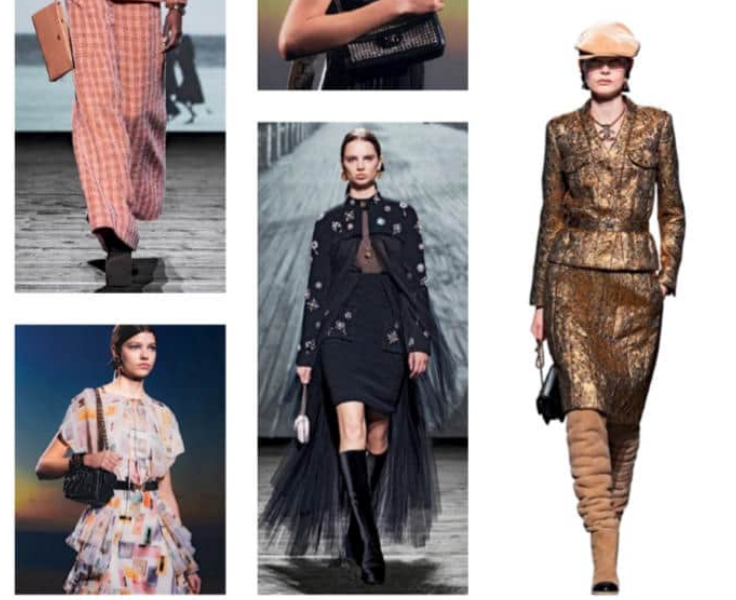
CHANEL
There is an affinity between the resort town of Deauville and the House of Chanel.
This was where Coco Chanel launched her millinery business in 1912, and where actress Anouk Aimée brought her own Chanel bag onto the Un Homme et Une Fille (1966) set one day, immortalising it in the annals of cinema. Thus, Virginie Viard looked to the intersection of the ’20s and the ’70s, paying homage to Deauville’s cinematic and Chanel-tied history. Tweed suits came in pale, dusty sunset hues of pink, violet and peach worn underneath dressing robe-like coats that draw direct inspiration from Coco’s own wardrobe. Chunky, cosy knits were perfect for those evening strolls along the boardwalk, whilst cocktail attire called for languid sweaters worn with stacks of Chanel necklaces. One tweed suit, cut more spaciously, was dotted in black crystals that caught the light as you walked and provided subtle shine, and a stunning LBD featured yards of ethereal tulle studded with plenty of Chanel’s signature Byzantine- inspired emblems.

BALENCIAGA
There’s been a lot of debate about AI: its effects on art, real vs. rendered, and what it means to be truly creative in the age of machine learning. Pre-show, the Maison’s creative director Demna Gvasalia mused about how even though luxury is defined by its scarcity, “what seems to be truly rare and finite right now is creativity itself. I believe that creativity has secretly become a new form of luxury.” Thus, in a tunnel of LED screens showcasing AI-generated scenes of pastoral landscapes and the streets of Paris, the clothes presented were humanistic in nature. There were gowns that could have been easily pulled from the brand’s archives and reworn sans ironing, while fur coats are laminated to create an intentionally worn-in look. Streetwear, Demna’s road to fame, still featured heavily in the form of tracksuits and down jackets blown to magnified proportions. Towards the end, Balenciaga paraded a series of “1 minute designs”, where Demna and team threw clothing items together spontaneously to create something entirely new. Dresses from recycled briefs or hoodies sewn together to form a skirt, as odd as they sounded, served as a reminder of Demna’s signature imagination.
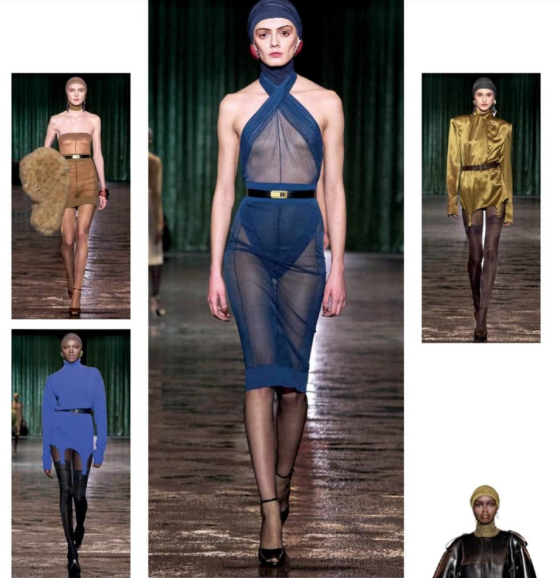
Saint Laurent
Anthony Vaccarello’s latest outing for Saint Laurent is radical for a number of reasons. Firstly, for a fall/ winter collection, this was a parade of looks cut from the same fragile fabrics used to make hosiery. Secondly, and perhaps more importantly, this was a collection that found a new way to imagine naked dressing. In Vaccarello’s vision, his muse can be wearing a blouse and skirt and still be very naked and sensual. The jumping point for him was Marilyn Monroe’s famous Jean Louis nude dress, and a sheer blouse that Yves Saint Laurent designed in the ’60s and scandalised half of Paris upon debut. This transmuted into a wardrobe that was straight- to-the-point provocative: pussybow blouses, tautly draped dresses and pencil skirts left little to the imagination in their variations of raspberry, camel, olive and Prussian blue. Certain looks came with chubby fur stoles, coats or structured leather coats and these characteristics of sultriness and puissant allure feel very now.
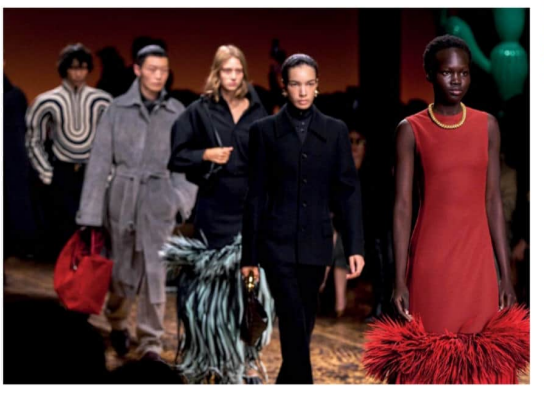
BOTTEGA VENETA
“In a world on fire, there is something very human in the simple act of dressing,” declared Matthieu Blazy of his fall/winter 2024 collection. The designer decided to pull back this season and focus on quotidian routines. Still, nothing is ever mundane with Blazy, who sent out look after look that exalted the art of dressing. Here were coats with rounded shoulders and full skirts that made walking to the office a fun exercise of movement, and plenty of tactile surfaces to find excitement in, from a fringed coat to the pleats that reveal different colours as you moved. Even his evening wear— lean dresses and skirts that explode into a flurry of fabric tentacles—were pieces that you could easily wear from 9-to-6 to your 6-to-9. On the accessories front, Blazy wanted them to appear as if they were inherited: a classic portfolio you might find in your mum’s closet, or Oxford shoes swiped from your dad. These are the pieces that will continue to transcend time, because as Blazy sums up, “elegance is resilience”.
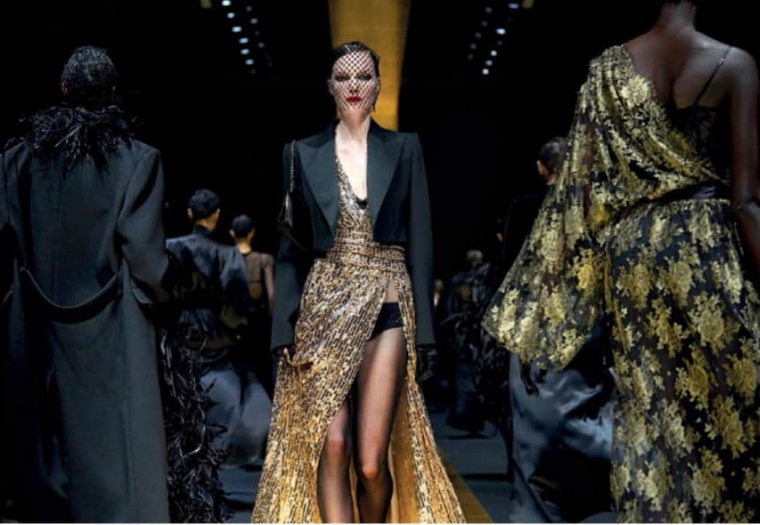
DOLCE&GABBANA
There was no mistaking what Domenico Dolce and Stefano Gabbana set out to focus on this season. Over 64 looks, the Italian duo sought to celebrate the tuxedo. Show notes highlighted the designers’ thoughts, stating “the simpler a piece, a classic like the tuxedo, the more perfect it is”, and in a season where so many other designers are jostling to offer their own take of the tuxedo, leave it to Dolce&Gabbana to prove that the Italians do it best. There were tuxedo jackets in every manner: cropped at the waist, elongated into coats, done without sleeves, done as a dress and so on. Alongside, there were also sensual lace bralettes, polka dots, and sparkly rhinestones to tempt and blind. Because most of the collection was rendered in inky blacks, Dolce&Gabbana chose to offer up plenty of textures to liven up the looks. Feathers, sporty mesh and velvet all made their due appearances, lending richness and dimension.

CELINE
This season, Hedi Slimane chose to riff the codes of fashion in the Sixties for his CELINE girl. This was, after all, one of CELINE’s golden ages, but under Slimane’s masterful direction, the looks paraded in a 12-minute video were just as referential as they were fresh. There were fabulously swingy miniskirts paired with boxy tweed jackets, chubby coats cut to look like snowballs and oversized pussybows galore. A-line dresses were cut with ruler-straight silhouettes and glistened with lashings paillettes—some shaped in the House’s Triomphe logo—while many of his models carried variations of the Triomphe handbag that are guaranteed to fly off shelves. The race to the moon was a big thing in the ’60s, and Slimane nodded to this in a Jetsons-esque swimsuit, minidresses encrusted with thousands of starlike crystals and the groovy go-go boots.
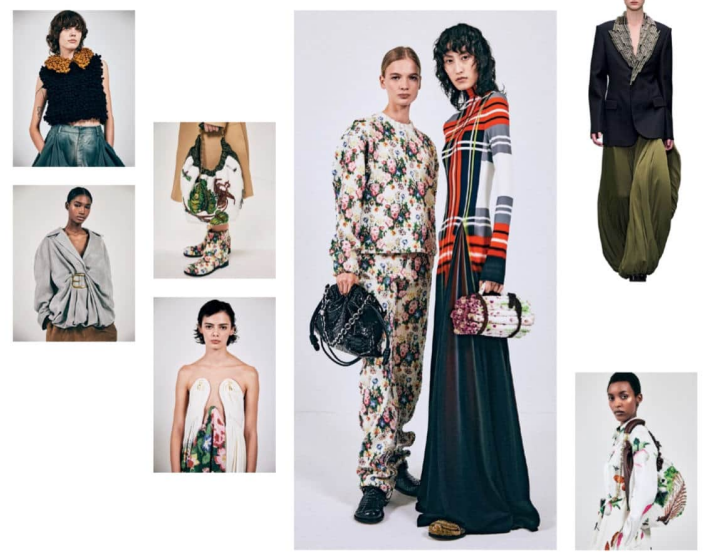
LOEWE
With a LOEWE collection, there’s often an expectation of, well, the unexpected. Jonathan Anderson’s approach has always been to connect the dots between seemingly disparate ideas in a way so meta that it could only be LOEWE. Anderson was transfixed by the idea of luxury, and the provenance of symbolic things. In a room lined with bucolic landscape paintings by Albert York—itself an irony given York was mostly a hermit, and yet his visions of outdoor life became prized collectibles—Anderson looked to things that were once considered precious. You had the pet tapestries that were the rage in the ’20s now making their caviar-beaded comeback on stiff dresses and sweatshirts. The refined floral tapestries of country manors are reimagined on asymmetric dresses and balloon trousers. Even the wood carvings seen in estate houses have been reappropriated into collars. Can a bag shaped like a bundle of asparagus be luxury? Under Anderson, the answer is a resounding ‘yes’.
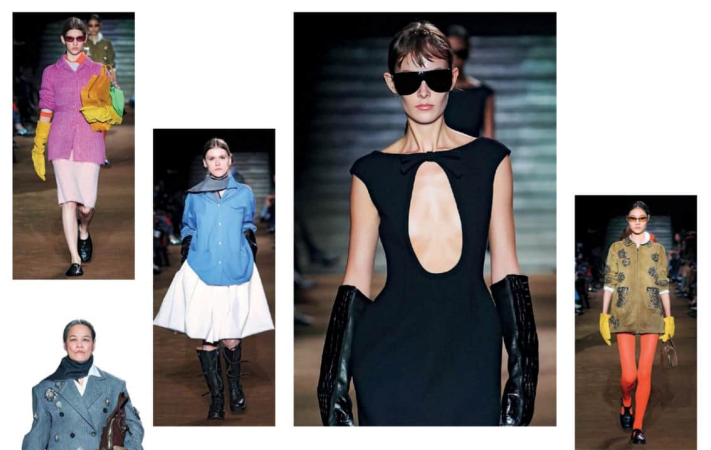
MIU MIU
Miu Miu has always set out to explore the many codes of girlhood, yet designer Miuccia Prada also knows that girls don’t stay girls forever, and it was in this deliberation of time that we find Miu Miu’s fall/winter 2024 show. In a stark departure from past seasons’ leggy looks, Miuccia’s opening outfits featured sober tailored coats that were worn over crisp, slim-cut white trousers. As they came down the runway, the clothes featured a mixture of grown-up elements with a spry touch, as if the Miu Miu girl is playing dress up in her mother’s wardrobe. Shrunken jackets, poplin shirts and fitted cardigans are worn with skirts featuring oversized blooms. Colours ran the gamut from business blacks and navy to effervescent tones of bubblegum pink, mustard and acid green. On customer-turned-model 70-year-old Dr Qin was an oversized wool coat covered in metallic floral brooches. It was the most succinct summary of Miuccia’s collection: the proportions of adult clothing made playful by the innocent curiosity of a young girl pinning her mother’s brooches all over.
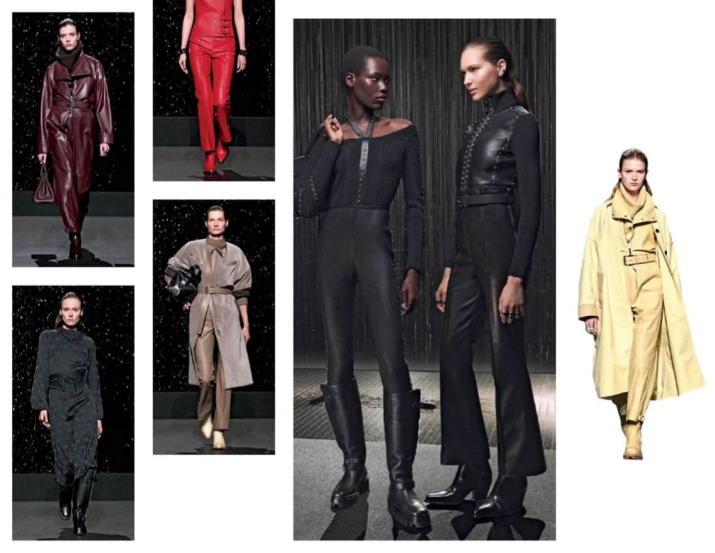
HERMÈS
In her fall/winter 2024 collection, Nadège Vanhee sought to draw parallels between two riders: the equestrian and the biker. Against the backdrop of a cinematically rain-slicked runway, she borrowed from both inspiration points to create a collection that was equal parts an homage to the House’s equestrian roots and her thrill-seeking, motorbike- loving alter ego. As a whole, the designer is never one to produce anything overly thematic, so any coatdresses. There were sexier nods to reference to bikers came in subtle nods. Leather, as always, played the star role, showing up in everything from supple blouson jackets with matching cigarette trousers to fiery red riding vests and the Harley-riding Hermès girl—pencil skirts were cut dangerously high, ribbed knit tops came cropped beneath the bustline, and a few looks featured harness straps sensually wrapped around the wearer’s neck. Was this a departure from her usual oeuvre? Yes, but what a joyride this was to see the Hermès woman embrace her rebellious side.

GUCCI
In his second womenswear outing for Gucci, Sabato De Sarno has continued his efforts in redefining the vocabulary that would colour his era at the storied Italian brand. Doubling down on his penchant for streamlined silhouettes, early runway exits saw a trim black jacket worn with micro shorts, as well as midi-length dresses darted to hug the body. Luxuriously soft wool cashmere rompers sat underneath elongated coats that swished about with sequin fringes, and oversized caban outers in rich shades of sky blue, butter yellow and olive green will appeal to those looking to add colour to their winter vacation wardrobes. The bombshell sex appeal often associated with Gucci was also given a De Sarno sheen through a parade of lacy numbers. On some models, they were sheer tops worn with heavy wool skirts and leather boots for a cool, downtown vibe, and on others, they came dotted with 3D-floral embellishments or spliced with velvet inserts.
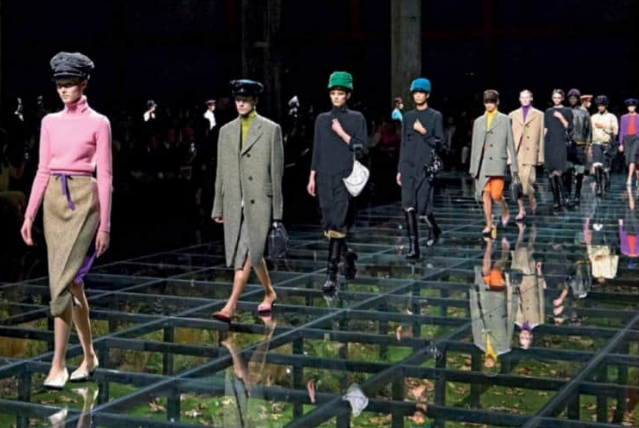
PRADA
The idea of looking to the past for inspiration is not new. After all, everything is cyclical, and just like that, something old can be new and cool again. Yet in the minds of Miuccia Prada and Raf Simons, their collection was anything but nostalgic. In essence, the pair wanted to examine clothing from the perspective of time, and in doing so, borrowed from different periods to amalgamate the designs. Column silhouettes referenced the look du jour of the wartime years, which was echoed in the plumed peaked hats resembling military officer caps. Dresses were cut with a dropped waist, nodding to the ’20s, and liberally covered in romantic bows or pillowy tufts of velvet applique, whilst apron skirts were worn with leather jackets that were borrowed from the grunge kids of the ’90s. Cocktail dresses that seemed to take on the demure, couture-like shapes of the 1950s were now cut from technical nylon fabric, as if blending past and future together seamlessly. “When you take fragments of history, how do you do them in a way that they don’t become nostalgic?” Simons explained to the press post-show. “We aim to be modern, something that feels fresh and new.”
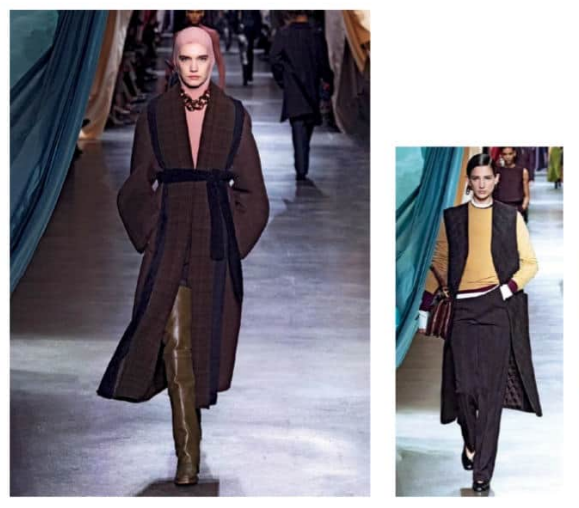
Fendi
As an Englishman leading the womenswear department of a distinctly Roman fashion house, Kim Jones’ work at Fendi has always been about honouring the House’s long-standing traditions while bringing his own Britishness into the fold. This season, Jones’ trip into the archives led him to the idea of New Romantics, where he branched out into notions of utilitarian clothing and the adoption of Japanese-inspired lines in the late ’80s. All of these points would melt together to inform his kimono-inspired necklines that accompanied no-nonsense suits, separates cut from khaki cotton that looked deceptively stiff but flowed freely as one walked, and knitwear layered in sleek, second skin-like fits. The real stars, however, were the outerwear that came in variations of manipulations, from crackled wax finishing to needle- punched and shaved down to resemble corduroy in a gradient beige. Appealing as they are, these pieces would also remain chic for time eternal.
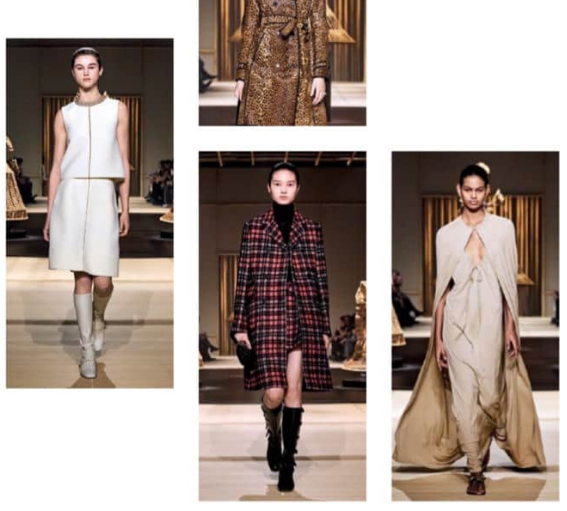
DIOR
In many ways, the collection that Maria Grazia Chiuri presented was about armour. Dotted around the room were armour-like sculptures made by artist Shakuntala Kulkarni, and when her models hit the runway, they wore armour of a different kind. Specifically, clothes inspired by the Sixties, a time where gender roles got a seismic shift and women needed clothing that worked in male-dominated office places. Chiuri was also looking at the now-defunct Miss Dior boutique started by her predecessor Marc Bohan in 1967, and the glamorous furniture designer Gabriella Crespi. Out of this, whiffs of the ’60s came in the form of miniskirts, knee-high boots and the graffiti-like Miss Dior logo splashed across everything from louche tailoring to shoulder purses. Chiuri knows her customers go to her for wardrobe essentials, and she delivered plenty of these in the form of clingy turtlenecks, classic trench coats and chic day dresses. The Bar jacket takes on a more masculine look with a looser fit and double- breasted front, while eveningwear calls for plenty of beaded, swishy gowns in a range of colours from white to silver, gold and gunmetal.
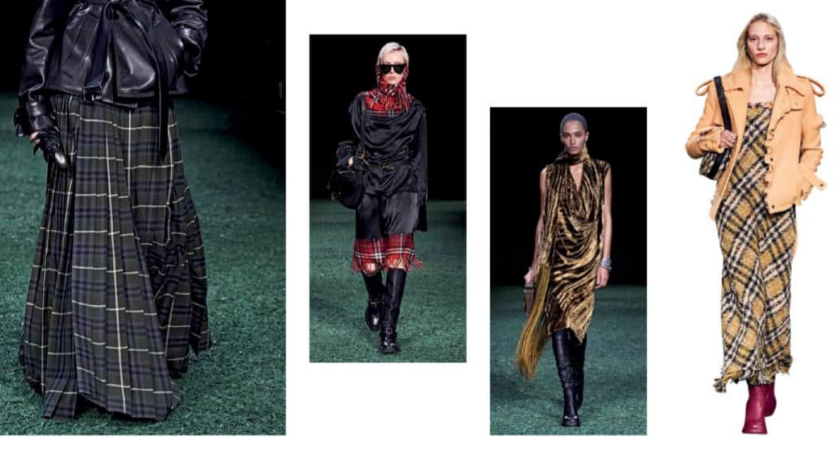
Burberry
Daniel Lee’s collection for Burberry opened with the return of supermodel Agyness Deyn, who was best known for her pixie girl cut in Burberry’s indie sleaze of the 2010s. Except this time, Deyn isn’t slouching in a leather jacket—indie kids have to grow up, after all—but walking in a classic grey trench coat, buttoned up high to face the English weather. Burberry is a generational brand, so Lee’s approach has always been to find a balance in appealing to both ends of the customer spectrum. Those looking to Burberry for sophistication will love his frilled coats, high neck blouses, the fur inserts on coats and knits, and the beautiful velvet fringe dress that showed up towards the end of the collection. Yet there was plenty for the younger audience, as evidenced in the Y2K-inspired low-waisted skirts and the oversized jackets. Slip dresses recalled the grunge era, whilst the leather boots worn by many of Lee’s models were perfect to stomp around in, be it on the pavements of London or the marshy fields of Glastonbury.
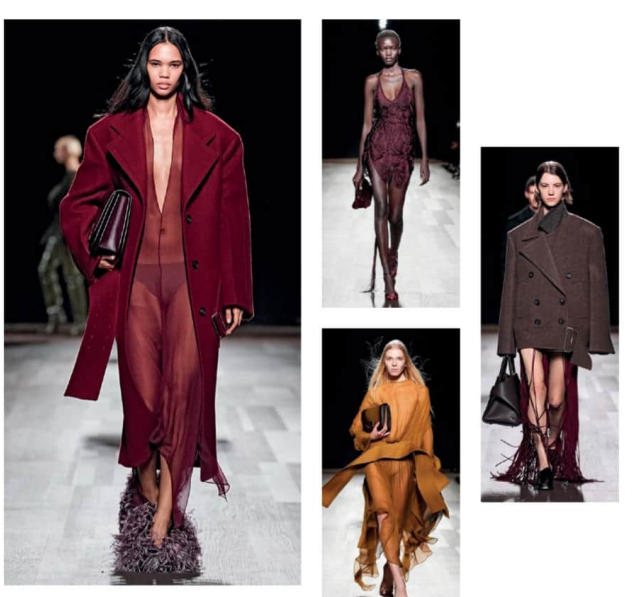
Salvatore Ferragamo
The 1920s have been a favourite era for mining inspiration, yet Maximilian Davis manages to do the same in a way that is surprisingly fresh. There aren’t your typical Josephine Baker dresses, instead, Davis wanted to explore how the ’20s “used clothing as a way to celebrate freedom”. He name-drops the likes of Joan Crawford and Greta Garbo—actresses who were lovers of Salvatore Ferragamo’s footwear, and who weren’t afraid to don gender-opposing garments—which manifested the mannish outerwear Davis is proposing for the daytime. The waists are cut lower, a clear hark back to the flapper dress’ drop- waisted silhouette, but in Davis hands, they now come with a wide military-inspired belt that lends modernity. Despite his deployment of officer-like tailoring, levity came in the form of feathers that sprouted up on the necklines of treated dresses; and in place of the usual and cliché beaded fringe one would associate with the ’20s, handkerchief hems in featherweight sheer fabrics and silk threads swayed with ease. Nothing about this collection felt reductive, instead it demonstrated Davis’ new energy.

LOUIS VUITTON
In fashion, with all of its comings and goings, 10 years can feel like a lifetime. In the case of Nicolas Ghesquière at Louis Vuitton, crossing the decade marker called for reflection in the time that he has spent at the house and in his designs from past years. The ruffled skirts from his fall/ winter 2020 show came with exaggerated volume. The frock coats from spring/summer 2018—one of which was worn by newly minted House ambassador Lalisa when attending the show—reappear in updated cropped shapes, whilst the tawny furs in patches of brown shades referenced a similar design from the fall/winter 2017 collection. Still, this is a Ghesquière for Louis Vuitton exercise, and the French designer always has a penchant for all things sci-fi. Early looks in the collection came in the form of cocktail numbers dotted with starry paillettes, technical track jackets, tailoring with moulded shoulders and draped minis. Louis Vuitton is synonymous with travel, and Ghesquière cued up dresses with photo prints of trunks and irresistible tracksuits washed in gold that promise to make companions to chic voyagers everywhere.